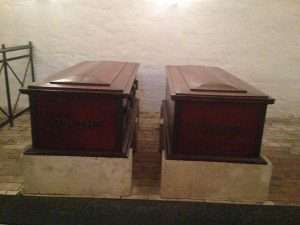Stepping out of the train station, I see a parking lot of cars contrasts the classic architecture that forms each building around the open square. I have been on this adventure as part of my assignment as the dramaturg for BYU's production of Mary Stuart. Now, I'm in Weimar, the place where Friedrich Schiller lived during the most prolific writing section of his lifetime. It feels quaint in this small town, now known for its profound influence on German culture and politics. This was the birthplace of German classicism and romanticism, and place where culture transformed into a world of free thinking and free expression. It was here in 1918 that the political leaders from around Germany joined together to write a new constitution after the dissolution of the monarchy post World War I. Weimar is recognized as the heart of modern, German culture, and this is where I stepped out to discover more about Friedrich Schiller and how it can help the production back in the United States.

Along my route to the Schiller Museum, I passed the National Theatre in Weimar, and gracing the front steps of the theatre, stands a statue of Schiller and Goethe. These two founders of Weimar Classicism proudly stand in front of the institution which thanks them for a rich history and culture that supports artistic creation. The Schiller Museum is housed in his home that he bought for his family in 1802. This purchase caused much debt for him, but his family lived in the house until 1826 when his wife, Charlotte von Schiller, passed away. This house used to sit on the edge of the town and overlook fields, but Weimar has evolved since then. I walk up to the museum that sits on Schillerstraße, and am shocked to find it painted yellow. Just the size of the house says volumes about Schiller’s fame during his lifetime. He was not one of those playwrights who became famous after death, but rather, was celebrated throughout his lifetime as a visionary and talented artist. This bright color is only the beginning of my discoveries about the life of Friedrich Schiller and the world in which he lived.

The museum begins with the history about Schiller. He was born in Marbach am Neckar in southern Germany on November 10, 1759. Throughout his childhood, he had private lessons with Pastor Moser. As he got older, he was sent to a military school by command of Duke Carl Eugen von Württemberg. The Duke had to command Schiller to go three times before he obeyed. Schiller originally chose to study law, but after two years, he started to fall behind, so the Duke commanded him to switch to medicine. After his graduation, Schiller was not given a good position from the Duke, and had to spend a few years as an army doctor, which he found incredibly arduous. It was during his time in school and in the army that he wrote his first play, The Robbers. It was performed in Mannheim on 13 January, 1782. Desperate to see his work on stage, Schiller secretly left Stuttgart without Duke Carl’s permission. It proved to be a widely popular play, but the joy of success seemed short lived. Having disobeyed the duke in leaving Württemberg, upon his return, Schiller was imprisoned for fourteen days and forbidden to write anymore. Unable to obey this command, Schiller fled Württemberg in September of that year in order to pursue the life he desired.

As I continue around the museum, I realize that he went through a period as a struggling artist. It’s clear to see that the wealth that produced this house did not come easily to Schiller. His second play, Intrigue and Love, was not as well received and offended the Duke of Mannheim. The Duke of Mannheim had the play banned, and Schiller lost his job as an in-house playwright. Trying to survive, he fell into massive debt. He worked continuously to try and get out of debt, but he became extremely sick, a sickness that never seemed to leave him for the rest of his life. He started to move around in an attempt to fix his many problems, but he was quite discontent. He eventually took an unpaid position at the University of Jena as a history professor. The Duke of Weimar, luckily, gave him a pension that slowly increased with Schiller’s renown.

Once inside the Schiller Residence, I am astounded by what I see. The Germany that I was expecting does not consist of brightly patterned wall paper or the freshness that comes from so many windows. This is exactly the kind of place where I would feel comfortable living. There is a feeling of peace and happiness that exudes from this house. For his time period, Schiller was one of the wealthiest men not a part of the aristocracy, but his lack of title always caused a bit of strife in his life. On February 22, 1790, he married Charlotte von Lengefeld, who did come from the aristocracy. Upon marrying someone in a class below her, Charlotte was ostracized from her former society. Despite Schiller’s success as a playwright, neither he nor his wife were allowed to attend royal gatherings due to their lack of a title. This was especially hard when Charlotte’s sister, Carolina, came to visit. Carolina von Wolzogen had married in her class, and was always invited to court in Weimar and Jena when she came to visit. That is, until 1802, when the Duke of Weimar decided to entitle Shiller by changing his name to Friedrich von Schiller. Then the sisters could again attend court together. Schiller managed to achieve notoriety that few in the time period could ever dream of.


Schiller’s most prosperous works come after his marriage and the French Revolution. Up to 1789, Schiller had been a huge proponent of revolution, especially after his experience of not being able to control his own fate. However, upon hearing of the bloody massacres of the Reign of Terror, Schiller realized that the people needed to be prepared for freedom or chaos would ensue. The rest of his plays reflected the importance of finding inner freedom and holding onto moral beliefs. Mary Stuart, the production that I have been studying this whole time, comes as a prime example of what is called Weimar Classicism today. This piece focuses on personal dignity and the importance of not losing oneself to the wiles of the world.

Schiller spent the later part of his life writing extensively, to the point where he produced a full length play every year. He had always struggled with health since his early years as a playwright, and this time of writing didn’t change anything. The last piece he was known working on was called Demetrius, a Russian based play. During his intense writing schedule, he got a lung inflammation that worsened in a matter of days. He passed away on May 9, 1805, and he was buried a few days later in the crypt of the St. Jacob’s church in Weimar. This church was also on my tour of the city, and I was once again amazed by the brightness and cleanness in the style of that time period. The church itself feels like hope. Yet this is not Schiller’s final burial place.

There’s one more place to see in Weimar before I depart. By now, the sun has come out, and it has turned into a beautiful spring day. I walk through a public park on my way to the Ducal Vault. This is a place that Duke Carl August had built in 1823 for the remains of his ancestors since the City Castle burned in 1774. They had managed to save some of the family remains, and they needed a place to rest. Schiller’s death at age 46 came suddenly and all too soon. His good friend, Johann Wolfgang von Goethe, said, “I thought to lose myself and lose now a friend and in the same moment, half of my existence.” In December of 1827, the Duke of Weimar decided that Schiller needed to be honored as one of the Duke’s own family. So he had Schiller’s remains moved out of the crypt in St. Jacob’s to his own family vault. Goethe was later buried next to his friend in the vault.

Now you may ask, how, after over 20 years, could they possibly know which bones belonged to Schiller? The truth is, they didn’t, but they remembered that he had a really big head, so the men in charge simply pulled the largest bones and put them into the coffin in the vault. In 1911, there were rumors that the wrong skull had been selected, and so they once again returned to St. Jacob’s, and extracted another skull that was entombed next to the original coffin. In 2006, scientists took samples from all the bones stored in the Ducal Vault to test their validity as Schiller’s bones. The result came back showing that none of the bones belonged to him. Since that discovery, the coffin has been left empty in the vault, but it still remains a place where people come to honor the classic German poets.

It’s a place where I came as well. This incredible man wrote for himself for the society he hoped to create. He shows a profound of example of someone willing to show the world his heart. In the world of art, I hope to be able to make a similar contribution. I am excited to bring my new discoveries and experiences back to Utah and the production that awaits me. I want to help this production honor the memory of this incredible playwright. I get on the bus, moving on from the world of Weimar, but I can’t help but look back one more time and think about the ways that one man in this small town has changed the world.



